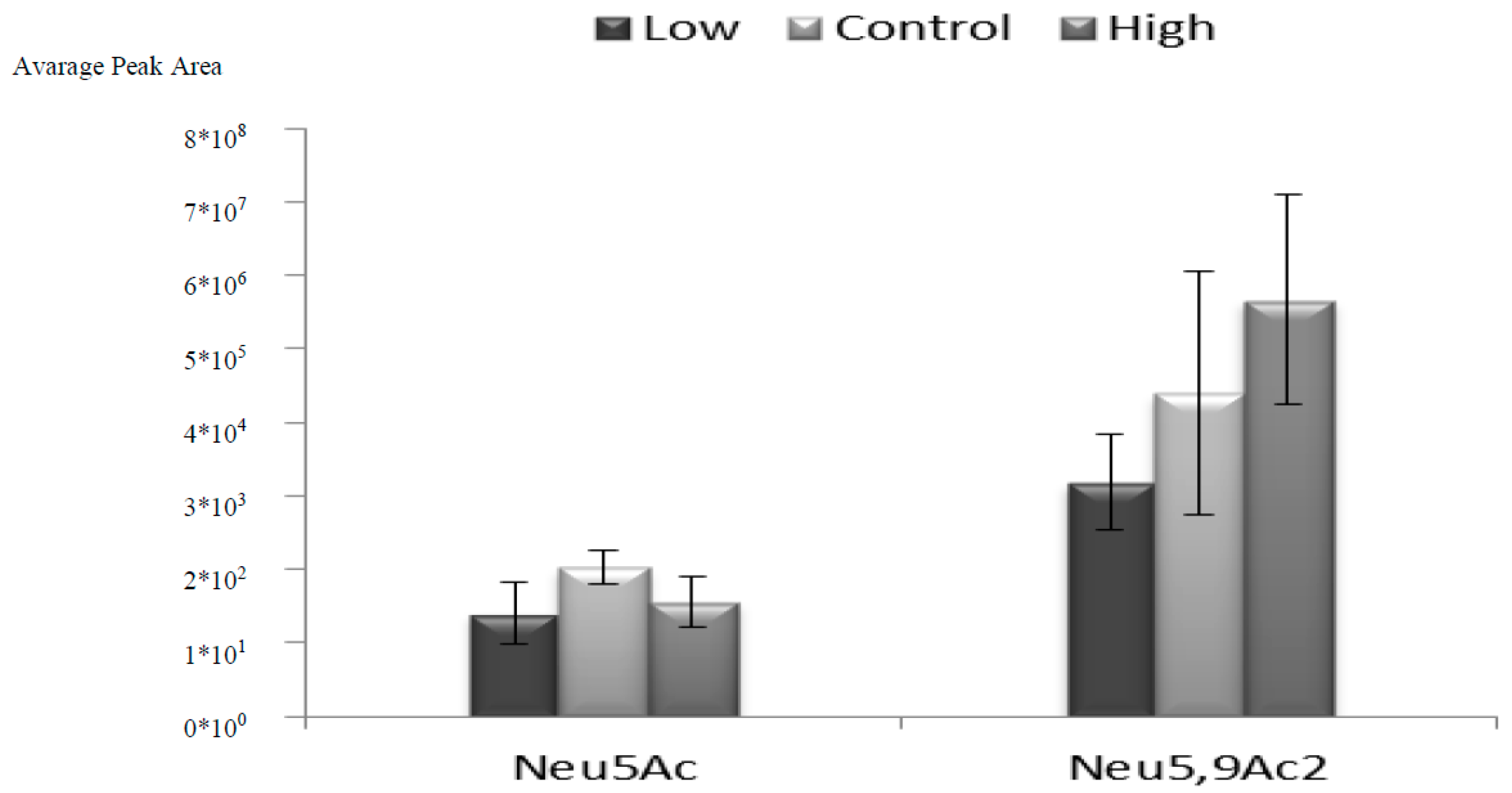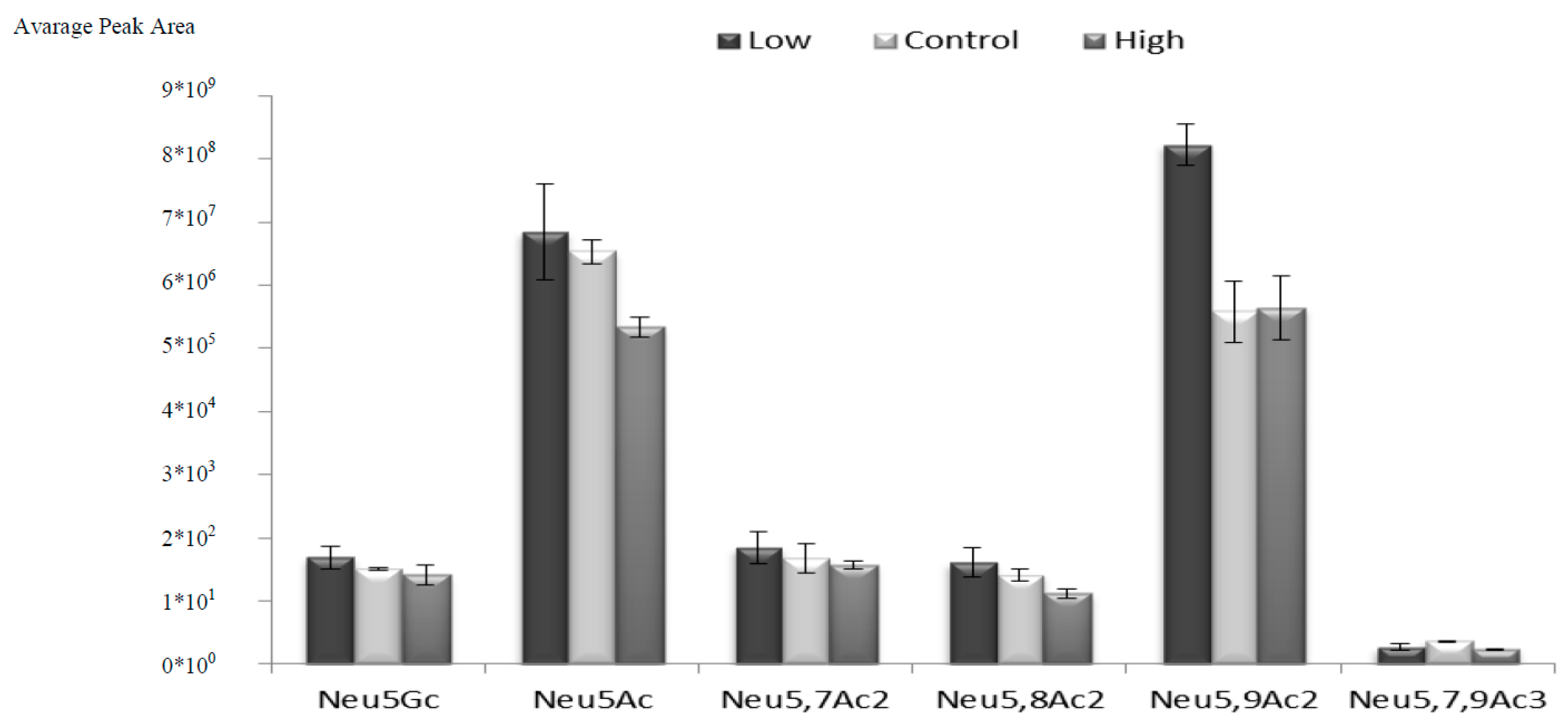1. Introduction
Nicotine, is an alkaloid compound consisting of pyridine and pyrolidine rings [
1]. Its closed formula is C10H4N2. During smoking peak plasma concentration changes from 25 to 50 ng/mL. Its half-life is 1–2 h. Nicotine is metabolized primarily in the liver and excreted by the kidneys [
2]. Adverse effects of nicotine and its metabolites on the fetus have been suggested but have not been proven by scientific explanations till now.
Sialic acids (Sia)s are modified nine-carbon sugars. They are located on the last end of the glycan chains located in the glycoconjugate structures. They organize a wide range of relationships between cells and their environment such as cellular recognition, adhesion, differentiation, aging and transmission. Sialic acids are a family of about 30 derivatives of neuraminic acid, generated by addition of different substituents at the amino group or at the hydroxyl groups at C4, C7, C 8 or C9. Various sialic acid derivatives is not yet fully understood [
3].
The aim of this study is to determine possible changes in the sialic acid levels and types in the plasma after different doses of nicotine applied to Swiss Albino rats in order to assess the effect of long-term per oral nicotine administration.
2. Materials and Methods
10 female Swiss albino rats with 200 ± 50 gr body weight (BW) were divided into two groups, as nicotine treated (nicotine group, n = 5) and nicotine untreated (control group, n = 5). Mating was achieved by two male rats for each group. All animals in the study group were housed under standard light (12 h day/12 h dark cycle) and temperature conditions. The control group was given only normal drinking water, but the nicotine group received 0.4 mg/kg nicotine ((-) Nicotine hydrogen tartrate; 2.22 mg/kg) via drinking water.
Newborn rats were divided into two groups, as the control and nicotine pups. The newborn pups stayed in the same cage with their mother to get breastfeed for around 6 weeks. After that they were separated from mums and put into new cages. All pups born from nicotine group parents continued to get nicotine in drinking water. Offspring who continued to receive nicotine were divided into two groups, the low-dose nicotine (LDN, 0.4 mg nicotine/kg BW/day) (n = 5) and high dose nicotine (HDN, 6.0 mg nicotine/kg BW/day) (n = 5) administered groups.
The blood samples were drawn at the end of the 12th month. Total and free Sia levels were analyzed in total plasma samples of control and low/high dosage nicotine applied groups by using HPLC-ESI-MS/MS.
3. Results
HPLC coupled with ion trap mass spectrometry was used for structural confirmation of the peaks. Total plasma samples analysis were carried out and six types of Sia were determined in all for control, low, and high dose nicotine groups. These six Sia types consist of;
N-Glycolylneuraminic acid (Neu5Gc),
N-Acetylneuraminic acid (Neu5Ac), 7-
O-Acetyl-
N-acetylneuraminic acid (Neu5,7Ac2), 8-
O-Acetyl-
N-acetylneuraminic acid (Neu5,8Ac2), 9-
O-Acetyl-
N-acetylneuraminic acid (Neu5,9Ac2) and 7,9-Di-
O-acetyl-
N-acetylneuraminic acid (Neu5,7,9Ac3) is shown in
Figure 1.
The more abundant Sia type found in the control group is Neu5Ac in comparison of the ratios of Sia’s types among themselves based on the peak areas. The amount of the Neu5,9Ac2 was the second abundant Sia among the others. Neu5Gc, Neu5,7Ac2, and Neu5,8Ac2 were found approximately at same peak area. The sixth and final Sia type is Neu5,7,9Ac3 that is found in the least amount. The distributions of total sialic acids in plasma were shown
Figure 2.
When all of Sia types were considered together, the total amount of Sia found at abundant in the control group. This is followed by a very small margin in the low-dose nicotine-treated group. The total amount of Sia decreased in the high dose nicotine group (control:Low dose:High dose = 44:43:37.5 unite)
Figure 3.
Proportional amounts of free Sia (Neu5Ac and Neu5,9Ac2).
Figure 3.
Proportional amounts of free Sia (Neu5Ac and Neu5,9Ac2).
Two types Sia were determined in free Sias in all control, low and high dose nicotine groups. Proportional amounts of free Sia (Neu5Ac and Neu5,9Ac2) are shown
Figure 3.
4. Discussion
Smoking addiction is one of the major problems of all the countries. There is not exact knowledge about which one of the more than 4000 chemical components that found in the cigarette is harmful for the developing infant during gestation period [
4]. There are some studies showing that NRT can be useful for women who cannot stop smoking during pregnancy because it just contains nicotine but no other oncogenic components found in the cigarette.
In this case, since the risk/benefit ratio of NRT application for pregnant women is still unclear, we need more comprehensive research on the NRT during pregnancy before making any judgement on this issue.
In this study, inspired from the oral route of NRT application in humans, all rats of study groups received nicotine by adding nicotine hydrogen tartrate into drinking water although in the literature generally short term parenteral nicotine administration was done. Also, there is no any study in the literature which investigates the effects of nicotine on total and free Sia’s in the plasma till today.
Sia’s are important molecules involved in many functions of the cells. However, it is well known that; high sialic acid levels were found in increased oxidative stress and are associated with many diseases such as diabetes and CVDs and even cancer. There are some studies showing high Sialic acid levels in serum related to various cancers seen in smokers [
5,
6]. Smoking causes to oxidative stress and related pathologies, similarly. Interestingly, in our study, nicotine led to a decrease in plasma Sia levels. Although, smoking causes an increase in oxidative stress and high plasma Sia levels, we found a decrease in plasma Sia levels in nicotine administration, suggesting that chemicals other than nicotine found in cigarettes can be responsible for the damage caused via smoking. In conclusion; in order to reveal these unexplained points, there is a need to investigate plasma Sia levels in nicotine consumption via smoking or via NRT.







